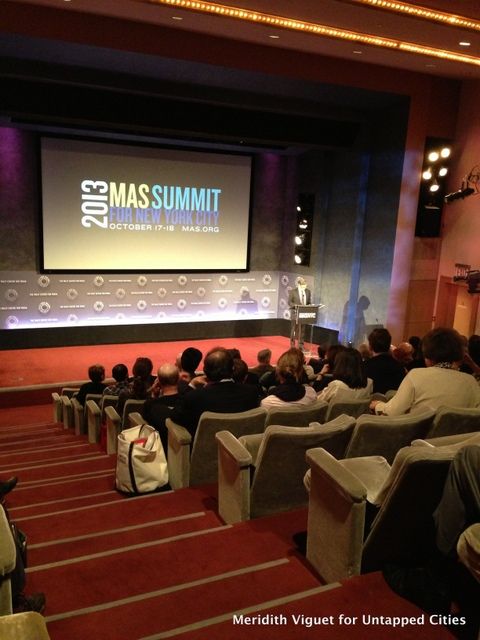Last-Minute NYC Holiday Gift Guide 🎁
We’ve created a holiday gift guide with presents for the intrepid New Yorker that should arrive just in time—


This week’s preview at the Paley Center for Media of the upcoming 2013 Municipal Art Society Summit for NYC provided exciting glimpses of two upcoming additions to the New York cityscape: the new Public Square at Hudson Yards and the Santiago Calatrava’s World Trade Center Transportation Hub at Ground Zero.
Calatrava first talked about his work in Qatar, where he has been designing plans for the multi-billion dollar Doha Bay Crossing, a revolutionary eleven-kilometer network of three bridges tunnels to connect different parts of the country. He spoke of bypass lane and using the bridges as venues for sport-related and cultural events, and explained his “focus on usability.”
Calatrava’s ability to mesh this usability with aesthetic elegance comes through in his stunning plans for the Transportation Hub at Ground Zero, a project due for completion in 2015. The hub’s final “oculus” design, meant to resemble a dove, is white, sweeping, and almost skeletal in nature. The pseudo-futuristic structure will feature retail locations and restaurants in addition to connecting visitors to 11 different subway trains, the PATH rail system, and the Battery Park City Ferry Terminal. Calatrava described the future connection site as a “commercial area that features everything that makes a city vibrant: commerce, human interaction…flashmobs.” At Untapped Cities, we’ve been visiting the construction site over the past 6 months, which you can see in a Google Glass video and in photographs.
Other speakers included Dr. Genie Birch, chair of the MAS board of directors, and Thomas Woltz, owner of Nelson Boyd Woltz Landscape Architects. Although Woltz has a heap of projects on his hands––he has worked with Houston’s Memorial Park, and perhaps most notably with his St. Louis City Garden––his plans for the new square at Hudson Yards have received the most attention by far.
The new Public Square, situated the heart of the Yards near 30th Street and 10th Avenue, aims to create a sort of “urban living room,” and to “create a human scale” among downtown’s enormous towers. Compared to Woltz’s soil-grounded projects, the Yards pose especially challenging horticultural limitations: his entire site rests on a seven-foot-thick concrete lid. As a workaround, Woltz used more geometric European plants as well as the plants from the connecting the last section of the High Line.
He explained his designs for the Square’s central double helix viewing tower, which builds on what he called the “human urge to go up eight to ten stories and look around.” A hallmark of his work, including his designs for the Yards, is a focus on the location’s character, specifically drawing on the location’s history––going back, in the case of Hudson Yards, to the 17th century––and using native plants.
Dr. Birch then explained the purpose and mentality of urban-focused scholars through her own personal story, emphasizing the necessity of people like Calatrava and Woltz. The rapid urbanization of areas in Africa and Asia, she said, how to unlock the land’s potential, what to do about the fluctuating prices of electricity––the same Dr. Birch herself teaches at Penn.
Perhaps Woltz best expressed the summit’s unifying theme: “Many things have come before us,” he explained. “Good design builds a bridge to those things––a bridge of affection, fondness, and stewardship.”
The MAS Summit for New York City will take place on October 17th and 18th and will feature one hundred speakers, including Dr. Anthony W. Marx of the NY Public Library, Mike Zuckerman of [freespace], Juliet Gorman of Etsy, and Robert Hammond from Friends of the High Line. Buy tickets for the summit here.
Subscribe to our newsletter